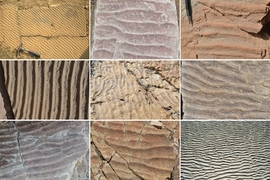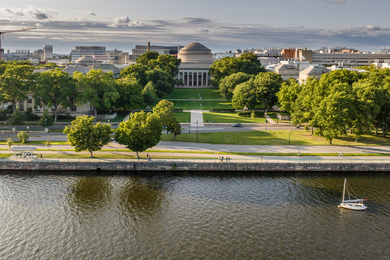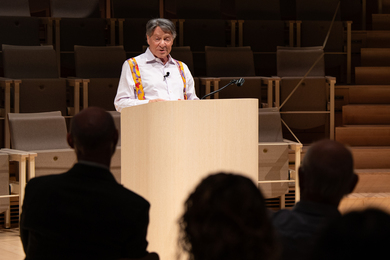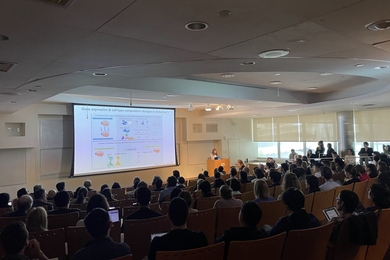In early January 2018, a nor’easter pummeled the East Coast. A record-breaking high tide rendered many streets in Boston impassable and seawater rushed down Seaport Boulevard in Boston’s Seaport District. A deluge of water poured down the steps leading down to the Aquarium subway station, forcing it to close.
Less than a week later, in a dry classroom on MIT’s campus, a group of students discussed how coastal cities like Boston can cope with worsening floods due to rising sea levels.
“We live in a coastal city, so obviously we are being significantly impacted by sea level rise,” says Valerie Muldoon, a third-year mechanical engineering student. “We talked about the bad nor’easter earlier in January and brainstormed ways to mitigate the flooding.”
Muldoon and her fellow students were enrolled in 2.981 (New England Coastal Ecology), a class that meets during MIT’s Independent Activities Period. The course is offered through the MIT Sea Grant College Program, which is affiliated with MIT’s Department of Mechanical Engineering.
MIT Sea Grant instructors Juliet Simpson, a research engineer, and Carolina Bastidas, a research scientist, use the four-week class to introduce students to the biological makeup of coastal ecosystems, to the crucial role these areas play in protecting the environment, and to the effects human interaction and climate change have had on them.
“We want to give a taste of coastal communities in New England to the students at MIT — especially those who come from abroad or other parts of the U.S.,” says Bastidas, a marine biologist who focuses her research primarily on coral and oyster reefs.
Muldoon, who is a double minor in energy studies and environment and sustainability, says she was “so excited to see a Course 2 class on coastal ecology.”
“I’m passionate about protecting the environment, so the topic really resonated with me,” she says.
The course begins with an introduction to the different types of coastal ecosystems found in the New England area, such as rocky intertidal regions, salt marshes, eelgrass meadows, and kelp forests. In addition to providing an overview of the makeup of each environment, the course instructors also discuss the physiology of the countless organisms who live in them.
Halfway through the course, students learn about how human impacts like climate change, eutrophication, and increased development have affected coastal habitats.
“We focus on climate change as it impacts coastal communities like rocky shores and salt marshes,” says Simpson, a coastal ecologist who studies how plants and algae respond to human interference. “There are a lot of interesting implications for sea level rise for intertidal organisms.”
Sea level rise, for example, has forced organisms that live in salt marshes to migrate upland. Changes in both water and air temperature also have a drastic effect on the inhabitants of coastal regions.
“As temperatures rise, all of those organisms are going to need to adapt or the communities are going to change, possibly dramatically,” explains Simpson.
Protecting coastal ecosystems has far reaching implications that go beyond the animals and plants that live there, because they offer a natural defense against climate change. Many coastal are natural hot spots for carbon capture and sequestration. Salt marshes and seagrass meadows all capture vast amounts of carbon that can be stored for several thousand years in peat.
“I was shocked at how much carbon the plants in these ecosystems can hold through sequestration,” recalls Muldoon.
Protecting these areas is essential to continue this natural sequestration of carbon and prevent carbon already stored there from leaking out. Coastal ecosystems are also instrumental in protecting coastal cities, like Boston, from flooding due to sea level rise.
“We talk about the ecology of coastal cities and how flooding from storms and sea level rise impacts human communities,” adds Simpson.
The class culminates in a field trip to Odiorne Point State Park in New Hampshire, where students get to interact with the communities they’ve learned about. Using fundamental techniques in ecology, students collect data about the species living in the salt marsh and rocky shore nearby.
Bastidas and Simpson will expand the class’ scope beyond New England in a new course — 2.982 (Ecology and Sustainability of Coastal Ecosystems) — which will be offered in fall 2019.
While the effects of climate change on coastal ecosystems often paint a dire picture, the instructors want students to focus on the positive.
“Rather than have students focus on the gloom and doom aspect, we want to encourage them to come up with novel solutions for dealing with climate change and carbon emissions,” adds Bastidas.
Muldoon sees a special role for mechanical engineers like herself in developing such solutions.
“I think it’s so important for mechanical engineering students to take classes like this one because we are definitely going to be needed to help mitigate the problems that come with sea level rise,” she says.












